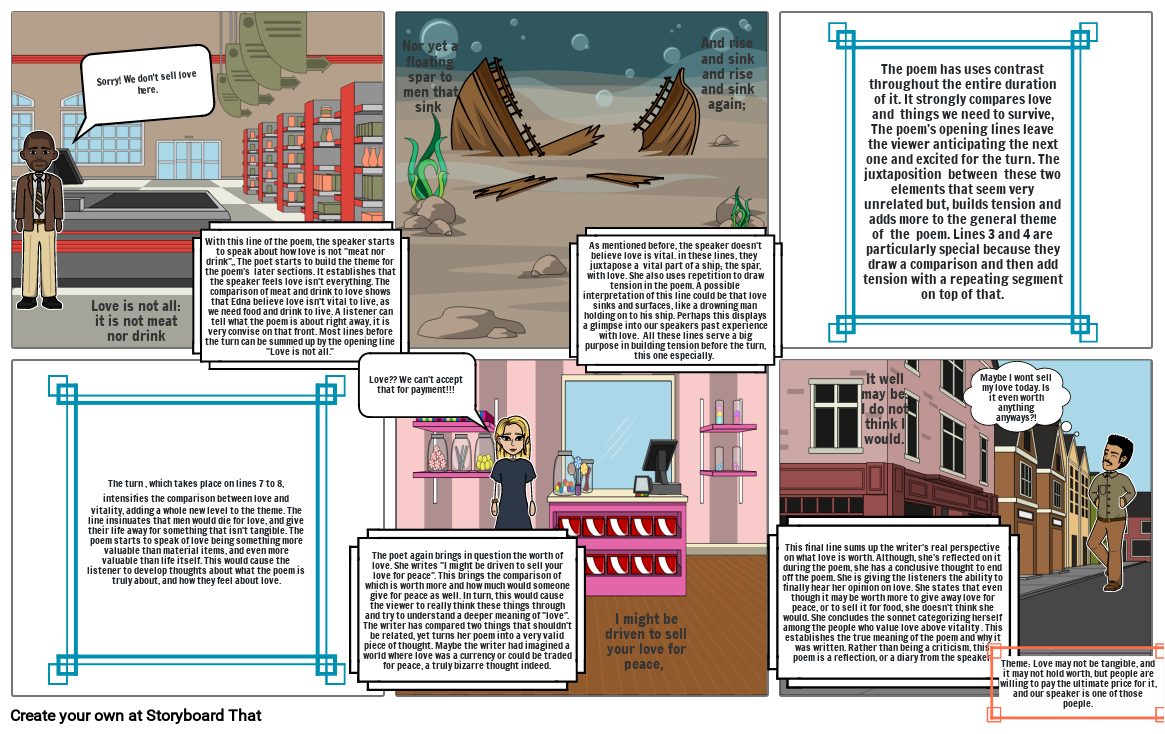
Storyboard Text
- Sorry! We don't sell love here.
- Love is not all: it is not meat nor drink
- With this line of the poem, the speaker starts to speak about how love is not "meat nor drink",, The poet starts to build the theme for the poem's  later sections. It establishes that the speaker feels love isn't everything. The comparison of meat and drink to love shows that Edna believe love isn't vital to live, as we need food and drink to live. A listener can tell what the poem is about right away, it is very convise on that front. Most lines before the turn can be summed up by the opening line "Love is not all."
- Nor yet a floating spar to men that sink
- As mentioned before, the speaker doesn't believe love is vital. in these lines, they  juxtapose a  vital part of a ship; the spar, with love. She also uses repetition to draw tension in the poem. A possible interpretation of this line could be that love sinks and surfaces, like a drowning man holding on to his ship. Perhaps this displays a glimpse into our speakers past experience with love.  All these lines serve a big purpose in building tension before the turn, this one especially. 
- And rise and sink and rise and sink again;
- The poem has uses contrast throughout the entire duration of it. It strongly compares love and  things we need to survive, The poem's opening lines leave the viewer anticipating the next one and excited for the turn. The juxtaposition  between  these two elements that seem very unrelated but, builds tension and adds more to the general theme of  the  poem. Lines 3 and 4 are particularly special because they draw a comparison and then add tension with a repeating segment on top of that.
- The turn , which takes place on lines 7 to 8, intensifies the comparison between love and vitality, adding a whole new level to the theme. The line insinuates that men would die for love, and give their life away for something that isn't tangible. The poem starts to speak of love being something more valuable than material items, and even more valuable than life itself. This would cause the listener to develop thoughts about what the poem is truly about, and how they feel about love.
- The poet again brings in question the worth of love. She writes "I might be driven to sell your love for peace". This brings the comparison of which is worth more and how much would someone give for peace as well. In turn, this would cause the viewer to really think these things through and try to understand a deeper meaning of "love". The writer has compared two things that shouldn't be related, yet turns her poem into a very valid piece of thought. Maybe the writer had imagined a world where love was a currency or could be traded for peace, a truly bizarre thought indeed.
- Love?? We can't accept that for payment!!!
- I might be driven to sell your love for peace, 
- This final line sums up the writer's real perspective on what love is worth. Although, she's reflected on it during the poem, she has a conclusive thought to end off the poem. She is giving the listeners the ability to finally hear her opinion on love. She states that even though it may be worth more to give away love for peace, or to sell it for food, she doesn't think she would. She concludes the sonnet categorizing herself among the people who value love above vitality . This establishes the true meaning of the poem and why it was written. Rather than being a criticism, this poem is a reflection, or a diary from the speaker.
- It well may be. I do not think I would.
- Maybe I wont sell my love today. Is it even worth anything anyways?!
- Theme: Love may not be tangible, and it may not hold worth, but people are willing to pay the ultimate price for it, and our speaker is one of those poeple.
Over 30 Million Storyboards Created
No Downloads, No Credit Card, and No Login Needed to Try!
